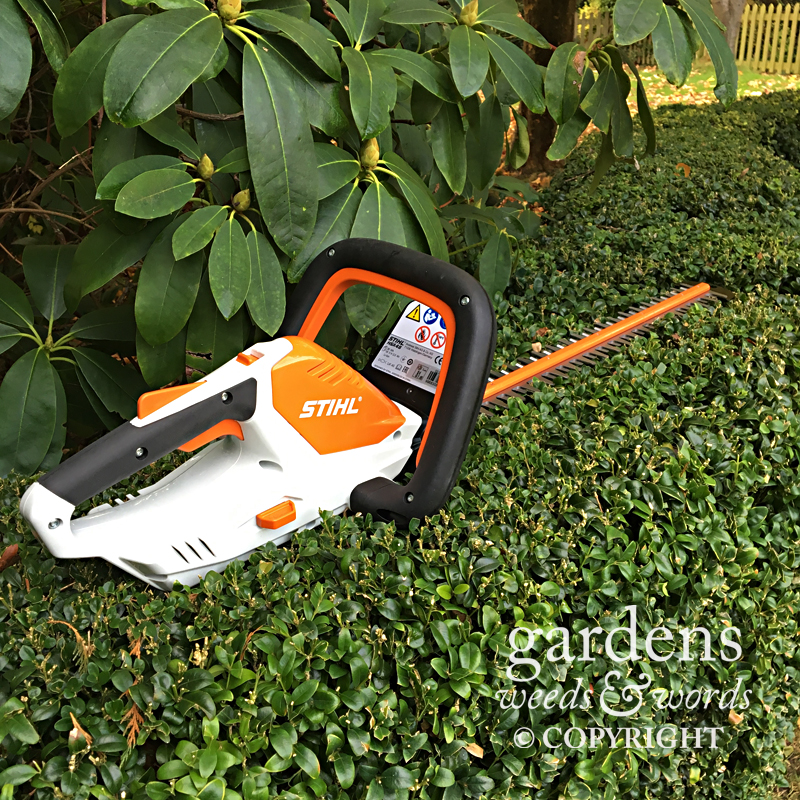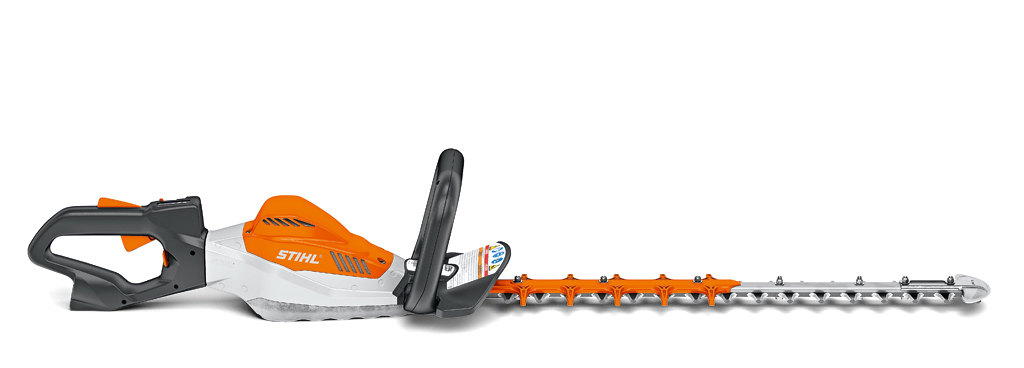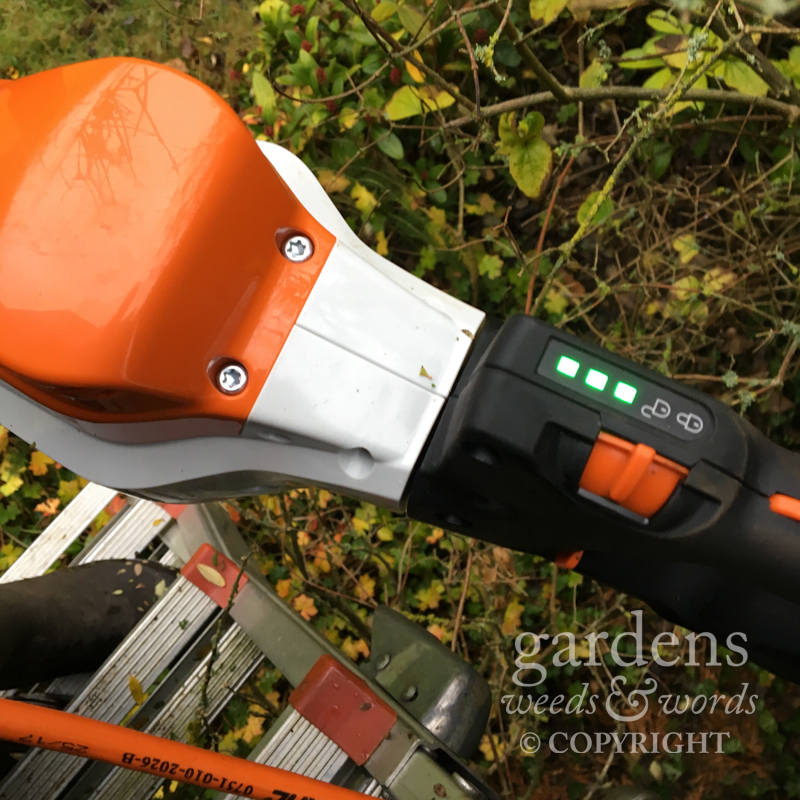Regular readers of the Gardens, Weeds & Words blog will know that I’ve been looking into gradually replacing my petrol gardening tools with their cordless battery counterparts. Last year I trialled a hedge trimmer from the new-to-me brand EGO Power+ (you can read my review of their HT5100E here), but I was particularly delighted to be asked by Stihl to have an in-depth look at their cordless hedge trimmers.
Stihl are a German brand whose quality tools are respected throughout the horticultural, landscaping and arboricultural sectors, and their characteristic orange and white livery is a familiar sight to those of us who work within those industries. I’ve gone on record to confess the joy I feel when working with particularly well thought-out hand tools in the garden, but there are many occasions when time constraints mean I need a little extra help, and when a machine is required it’s invariably to this brand that I will turn. There’s something about the build quality and ergonomics that inspires confidence, at least with the two-stroke kit. Would this brand loyalty transfer to the new battery tools? I was keen to find out.
Stihl’s Battery Power portfolio covers the full range of tools, including chainsaws, grass trimmers, brushcutters, leaf blowers and mowers. The technology is based on Lithium Ion cells, which charge quickly and suffer none of the memory-effect problems that caused Ni-Cad batteries to gradually lose their ability to return to full capacity. There are three sub-ranges aimed at different kinds of customer – the AP range for professional use and large gardens, the AK range for medium to large gardens, and the AI range for small gardens. Having been generously given access to the entire gamut of tools by the awfully nice people at Stihl, we decided between us that it would be interesting to look at both the smallest, and the largest hedge trimmers, and soon I was in receipt of the diminutive HSA 45 from the AI range, as well as the much more hefty HSA 94R from the AP range.
HSA 45
First impressions
This is a tool aimed squarely at the domestic customer with a small garden – a recently entered sector for this brand. Once I’d got over the initial shock of seeing the Stihl branding on a tool at a relatively low price point (£99), I was pleasantly surprised to discover the quality seems to be as I’d expect from this marque, only in a smaller package. The only element with a clearly budget feel is the orange blade guard, constructed from thin, folded plastic – perfectly adequate, but not the sturdy moulded sheath I’m used to seeing on the pro tools.
I noticed that there’s nowhere to load in the battery, and a small socket for a power cable reveals that the rechargeable cells are completely sealed in. There’s a safety key which needs to be slotted into place before you can operate the blades, and the usual three-part safety power switch with an additional locking switch providing extra safety.
Weight
At 2.3kg this is a very light machine – you can lift it with two fingers, and barely feel the weight in use.
Ergonomics & build quality
The balance of the machine, the quality of the materials and the thought that’s gone into the design are typical Stihl, and it’s good to see these production values transferring to the domestic range. This trimmer is so comfortable in use, a really nicely designed tool that is easy on your arms and hands, with all the controls falling perfectly into place to make the use of the trimmer completely intuitive (once you’ve worked out that you need to put the safety key in. That threw me a bit, but my fault for being so eager to try it out and skipping a page in the manual).
Blade and gearing
This is not a tough machine for thick growth and long use. The torque is low and the quoted maximum thickness it will cut is 8mm, though I managed a little more on a rough old mixed native hedging containing ash, holly and Lonicera nitida (poor man’s box), not to mention a fair helping of brambles. It coped admirably and gave a good finish, albeit at a fairly slow pace. It also took its time cutting through the young, but fairly dense and sappy growth on box hedging, but again achieved a good result.
Noise and vibrations
This is whisper quiet, with barely any vibration transferred to your arms and shoulders. It was a joy to handle and use.
Run & charging time
40 minutes run time, with a charging time of 210 minutes.
Cost (RRP)
HSA45 Hedgetrimmer £99
Overall
Yes, it’s rather slow, and compared to what I’m used to, certainly underpowered. My head says spend the extra on the mid-range tool (HSA 56), with its removable battery and greater cutting capacity. But my heart is tugged at by the excellent design, light weight and ergonomics, and I’m reminded that I’m not the target customer for this machine, which is, after all, a very capable option for a small garden, providing you’re not in a hurry – and in all honesty, when you’re not doing it for a living, cutting hedges is never something you should do in a hurry. Having said which, it’s earned a place in my regular tool kit, and I’ve begun to reach for it whenever there’s a slightly wafty edge to a modestly sized hedge I want to keep crisp.
The Stihl HSA45 cordless hedgetrimmer from the AI range for smaller gardens
HSA 94R
First impressions
This is a beast of a machine, but rather an elegant one at that. It’s the battery equivalent of my petrol powered HS81R with the 75cm blade, my workhorse hedge trimmer, which gives me a good range of cut from the ground or up a ladder without having to resort to my petrol kombi-system with the long-reach trimmer (HL-KM 145). It’s well balanced, and feels reassuringly sturdy.
The battery isn’t carried onboard, and I had two options – the belt-worn AP300 and high-capacity backpack battery AR1000. Both distribute the weight of the trimmer and power cells around your body, with obvious advantages in respect of manoeuvrability and operator fatigue. A thick power cord runs from the battery to a socket on the handle of the machine, and both the belt and the harness for the backpack feature securing straps to help route the cable around your body – a thoughtful solution to a slightly frustrating necessity. I could tell from the outset that the cable is something I was going to have to get used to.
Both batteries plug into a separate charger – Stihl had sent me the AL-500 Hi-speed charger, but the AL-300 is also available at a lower price point. It does exactly the same job, but at a more relaxed pace than the AL-500.
The Stihl HSA94R hedgetrimmer from the AP range of cordless tools
Weight
The trimmer itself is 4.4kg, which isn’t fantastically light, but is pleasingly less hefty than its petrol equivalent.
The AR1000 high-capacity backpack battery weighs 5.5kg with the harness, and the AP300 battery weighs 1.7kg.
Stihl’s high capacity backpack battery AR1000
Ergonomics & build quality
A beautifully balanced piece of equipment in the hands, with all the controls falling just where you’d expect to find them under the fingers. There’s the usual safety approach to the power switch which is split, requiring both hands to be gripping a handle before the blades will move, which works faultlessly. And an extra switch on the rear handle which allows you to select three blade speeds (levels 1 to 3) according to the job in hand. Being the PRO version, this machine has the rear rotating handle, which is a godsend when cutting vertically right up against the face of the hedge. I’ve already mentioned the cable routing system, which prevents you from getting into a tangle – you do, however, need to allow yourself enough length of cord to manoeuvre the machine, and this comes with practice. In use, once either the backpack or belt-worn batteries are fitted, you really don’t notice them at all.
The belt-worn AP300 battery from Stihl with cable-management loops which help prevent a tangle
Not looking so clean now! The HSA94R covered in leylandii clippings and still going strong
Blade and gearing
Although all the Pro machines are badged as hedge trimmers, Stihl differentiate between trimming blades with the designation T, for fine cutting of small leaved hedging plants and topiary, and cutting blades (designated R), which have a wider gap between teeth and a slightly lower gearing ratio and slower blade speed, making them perfect for more robust jobs cutting thicker, older growth. This is the R version, and has so far dealt happily with everything I’ve put in its way, from sappy young growth on leylandii to thick, overgrown stems on a mixed native hedge.
Noise and vibrations
For anyone used to a petrol machine, it takes a while to get used to having a similarly powered tool which is so much easier on both the ears and the body in general.
Run & charging time
With the belt-worn AP300 battery: 35 minutes to full charge with the AL-500 Hi-speed charger. Up to 135 minutes run time at level 1
With the backpack AR1000 battery: 120 minutes to full charge with the AL-500 Hi-speed charger. Up to 380 minutes run time at level 1
Cost (RRPs)
HSA 94R Hedgetrimmer £475
Battery options
AR1000 £630
AP300 £187
Battery belt for AP300 £100
AL-500 Hi-speed charger £120
The power level switch on the HSA94R
Power cable and handle-mounted socket
Overall
In use, the machine is quiet, but with all the power you’d expect from a professional level tool. I certainly missed nothing about my petrol version, and the reducing in weight of the main unit made it a pleasure to use.
Both the belt and backpack batteries are so well designed you hardly know you’re wearing them. The necessary cable is taking some getting used to, as although barely noticeable on the ground, it’s more apparent when you’re working up a ladder on a tall hedge. Not that it gets in the way, it’s just that you feel more tethered to the equipment than you would with either a petrol machine, a corded electric trimmer, or one with an on-board battery (notwithstanding the hit on weight and manoeuvrability that would entail).
This comes to the fore when moving your ladder – at which point, you need to put the machine down, which means either divesting yourself of backpack or belt battery, or (more likely), pulling the cable out of the trimmer. The power socket in the machine’s handle seems robust and well made, relying on the friction of a firm fit to hold the connection, and requiring a good pull to remove the cable. One solution would be to take a lesson from the arb guys and use something like the Petzl Caritool to hang the hedgetrimmer from the battery harness, leaving both hands free and relieving the wear on the socket.
Of course, this may well be me worrying unduly and, with time, I’m sure I’ll become accustomed to the new way of working. There’s certainly no sign of wear to socket or cable yet, and this aside, the entire experience is so far above that of using a petrol machine it almost renders comparison redundant.
Conclusion
I was already pretty sold on cordless battery power tools when I reviewed a competitor’s product last year, but being able to keep all my kit within the Stihl stable when I convert from petrol is really the ideal for me, and I’ve been delighted to discover that the quality and attention to detail that I’ve come to expect from their tools has transferred to the cordless lines. The introduction of a suite of battery-powered tools for the domestic market is a welcome addition to the Stihl portfolio and one the consumer can only benefit from, while the AP badged tools offer that combination of ruggedness and well thought-out control that those of us who earn our livings with this equipment have come to take for granted. For those who want more power than the Lithium Ion tools but with the benefit of an onboard battery, don’t forget the AK range featuring the HSA56 hedge trimmer – a review of that machine will be coming to the blog soon.
Have you tried any cordless battery powered garden tools yet? I’d love to hear your experiences, so do let me know either on Twitter, or in the comments below.
With many thanks to Stihl for supplying the equipment in this post in exchange for a fair and balanced review.









